Review of the Sabrent Rocket Q4 PCIe Gen 4 NVMe SSD
The versatility of modern SSDs is something that continues to evolve. Whether you are buying an SSD for its price tag, its speed, its durability or its sheer size, there is almost certainly an SSD that fits your needs. Now that the latest generation of M.2 NMe SSD has exploded on the scene with PCIe 4.0 x4 architecture, it has not taken long for SD manufacturers to diversify their existing ranges in order to facilitate these different buyers in this new storage tier! Sabrent has really fleshed out their Rocket series exceedingly quickly, taking the support of PCIe 4 M.2 NVMe and creating 3 separate revisions that fulfil different needs. The Rocket 4 Plus for the high-end pure performance, Rocket PCIe 4 for balanced performance Price with better durability and finally (being reviewed today) the Rocket Q4 series, for high capacity at the lowest available price per TB. Low-cost QLC NAND is by no means a new thing, garnering a questionable reputation among SSD purists, but this is one of the earliest examples of QLC NAND equipped SSDs arriving with the PCIe4 NVMe M.2 architecture, thereby surpassing their PCIe 3×4 alternatives before them in the Samsung QVO and Corsair MP400. However, the Sabrent Q4 SSD is not going to be for everyone, so today we are going to review this SSD, see how it compares with alternative SSDs in the Sabrent Rocket Family, as well as high-end PCIe alternatives from Seagate and WD to see just how big that disparity is.
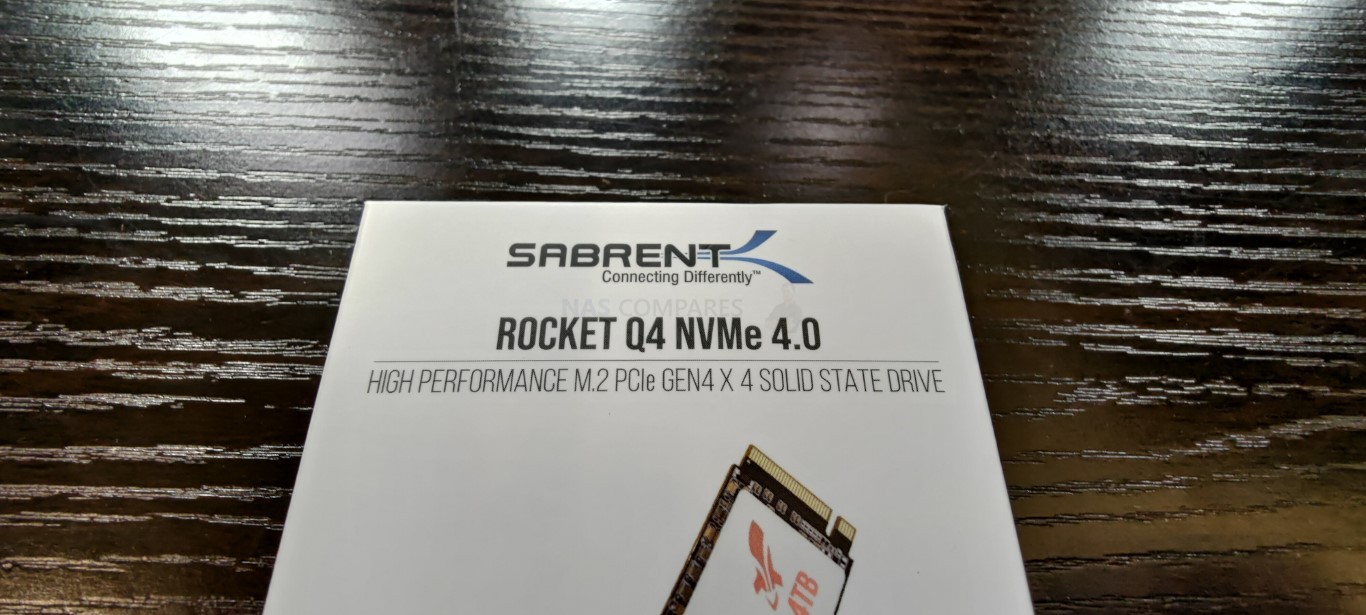
Sabrent Rocket Q4 SSD Review – Quick Conclusion
If you are considering the Sabrent Rocket Q4 SSD and are WELL AWARE of what QLC NAND is and exactly WHY this drive is noticeably lower in price than the likes of the Sabrent Rocket 4 Plus, Firecuda 520 and WD Black SN850 – then I can 100% say that the Sabrent Q4 is easily one of the best examples of Quad Layer NAND utilization in the market right now. It leverages the dips in performance and durability inherent in QLC NAND against the massively increased bandwidth of PCIe4 remarkably well. Additionally, it arrives on the scene as easily the lowest price PCIe4 NVMe SSD on the market right now, along with impressive build quality and presentation (Acronis drive cloning software included too). The warranty registration seems like a bit of a needlessly ambiguous hurdle and I am surprised that an 8TB Rocket Q4 does not exist right now, but aside from those factors, this is a great of example of presenting a QLC SSD done very well. Just make sure you are fully clued up on the reasons why QLC NAND is a little shunned in prosumer SSD circles.
| PROs of the Sabrent Rocket Q4 | CONs of the Sabrent Rocket Q4 |
| The Most Affordable PCIe4 M.2 SSD on the Market
Still Using a Great Controller in the Phison E16 Good Quality Build 4TB Version available Good for those with Modest PCIe4 systems Includes Acronis True Image to clone/move OS to drive PCIe4 SSDs at PCIe3 Prices |
QLC NAND = lower performance and lower durability
No 8TB model is currently available (one of the benefits of QLC NAND at 2280 length) Inclusive Heatsink Model does not arrive pre-installed/attached |
Sabrent Rocket Q4 SSD Review – Packaging
Much like the majority of Sabrent SSDs, the Rocket Q4 is a very well presented drive. Arriving in a smaller retail box than their competitors, there is the hesitation that this drive is not going to be suitably protected or corners have been cut. However in reality this is one of the most impressively packaged (aesthetically and protectively) M.2 SSDs I have seen in a long time.
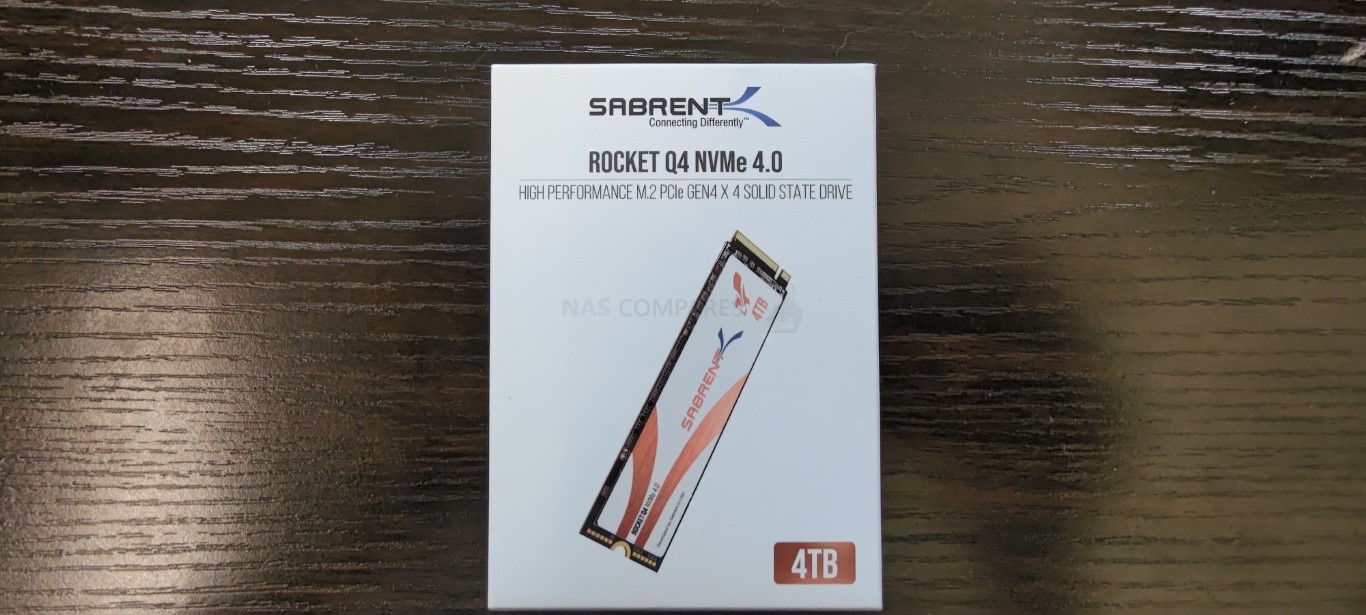
Inside the retail box (with its promised performance abilities and specifications detailed) is a copper hinged case that is surprisingly sturdy and gives off a nice feeling of quality.
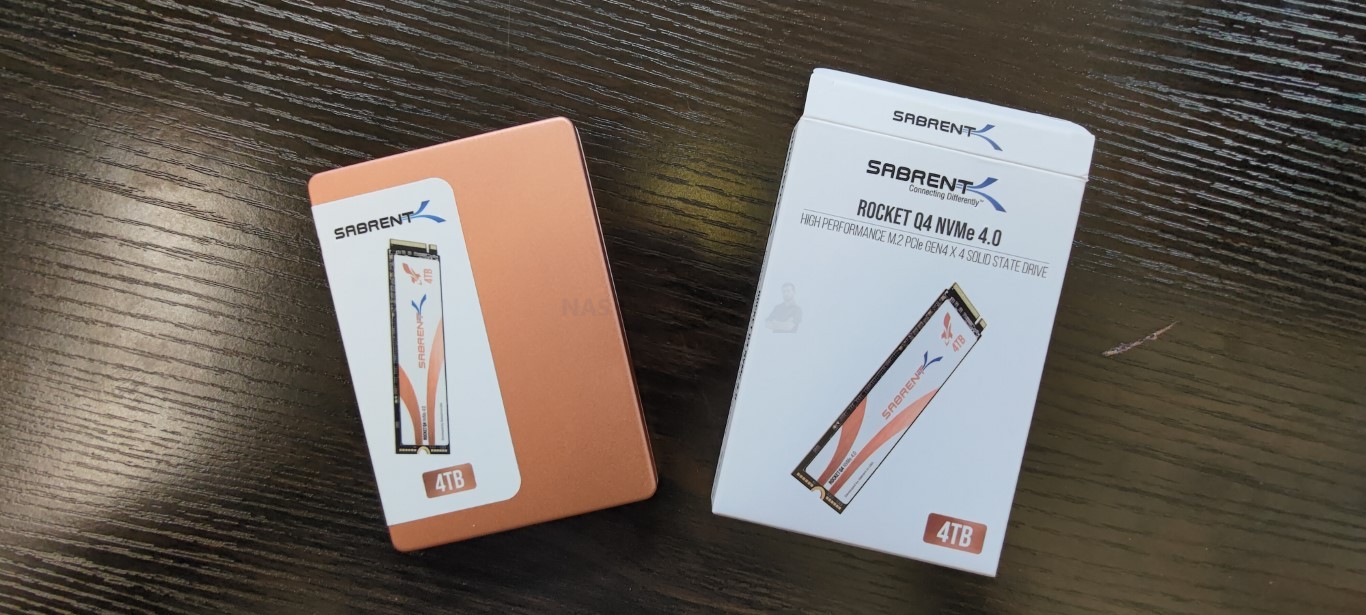
Inside this copper/rose-gold case is instructions for first-time drive installation, warranty information (which you are urged to register for, else you only have 1yr warranty as opposed to the expected 5yrs), a foam branded card that protected the M.2 NVMe and (of course) the Sabrent Rocket Q4 itself.
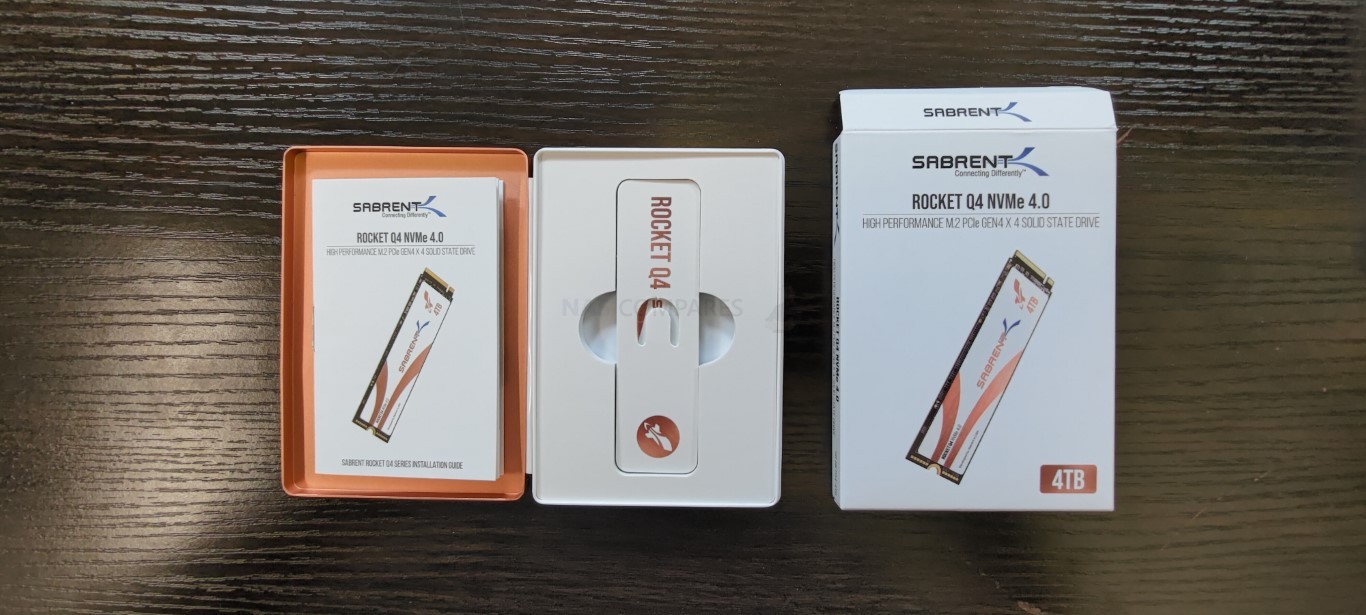
Removing the Sabrent Q4 SSD from the carry case show you a nice and clear drive label. Indeed this label is also a little different from those that you might find on other SSDs.
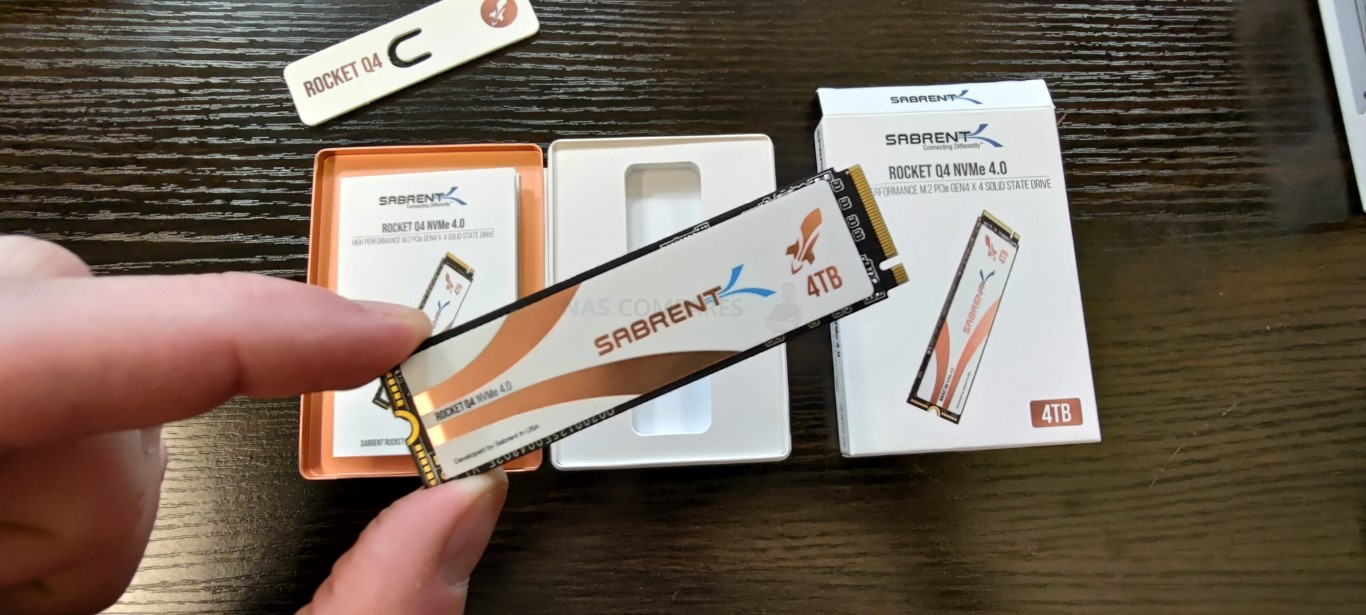
The top label of the Sabrent Q4 SSD is actually a metal place that lies across the entirety of the SSD. This plate is attached with adhesive and is present on all Sabrent NVMe SSDs, including this more affordable Q4 SSD. Later we will peel back this metal plate to show you the internal NAND, Controller and Memory, but this is still a very slick touch and although I query its effectiveness in real-world usage for heat dissipation, it’s still a nice extra touch of design.
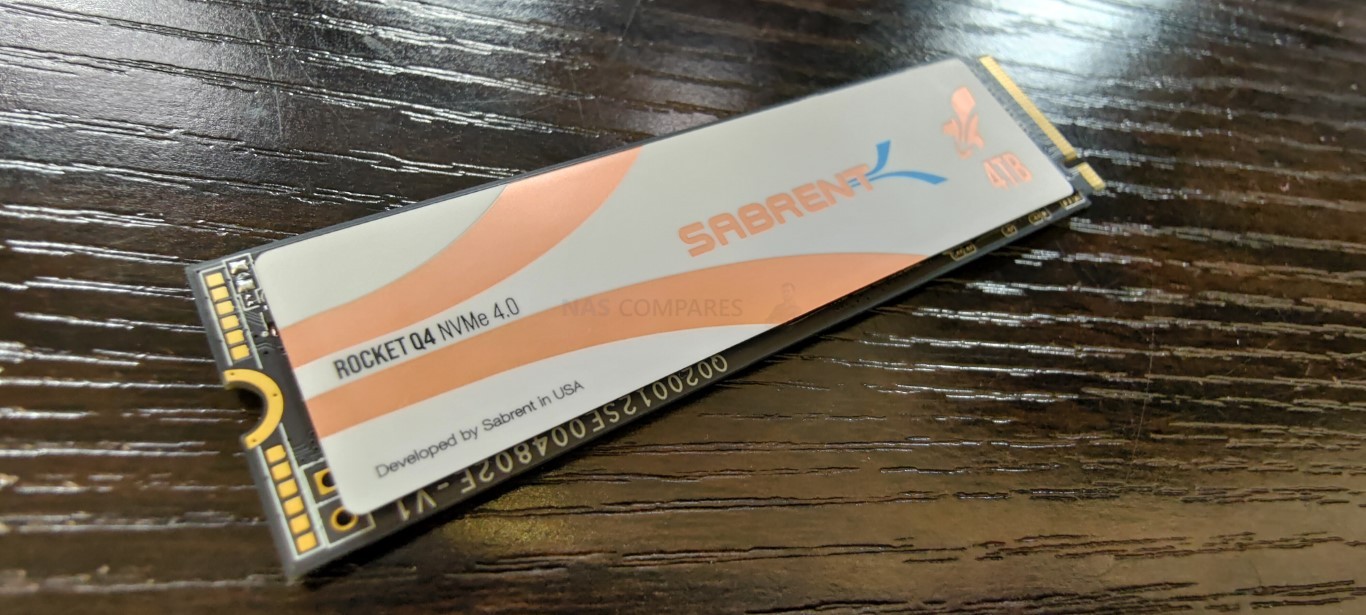
The m.2 Connector on the Sabrent Rocket Q4 has plenty of clearance and the distribution of the NAND on this 4TB drive is very even. Indeed, unlike the TLC version of this drive in the Rocket 4 Plus series, the NAND only covers 75% of the PCB in total (unlike the crammed 100% coverage of the Rocket 4 Plus) due to the QLC NAND having more space crammed in per module.
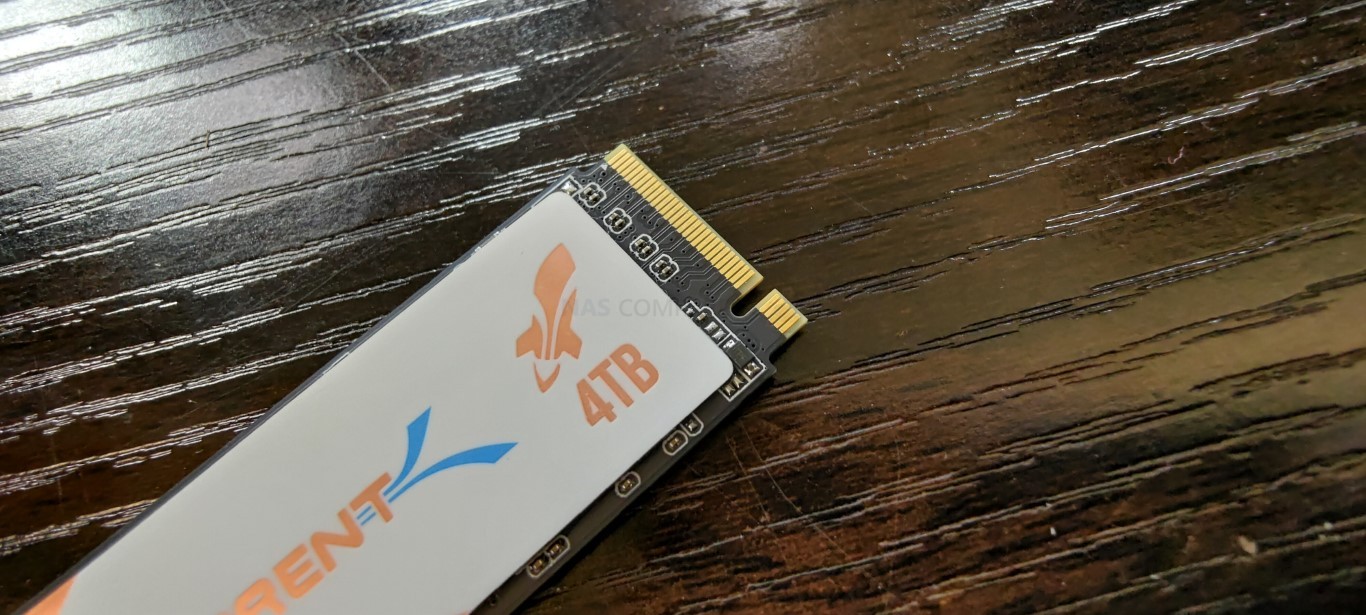
Of course, if you are going to deploy the Sabrent Q4 SSD in your PC or PS5 console, it is worth remembering that these drives get hot, plus in the case of the Sabrent Q4 it gets remarkably hot! To counter this you can always get a 3rd party heatsink OR get the Sabrent Q4+Heatsink package. The heatsink that Sabrent supply for this SSD is both stylized similarly to the drive itself and made of impressive build quality. However, there are a few caveats that are worth keeping in mind.
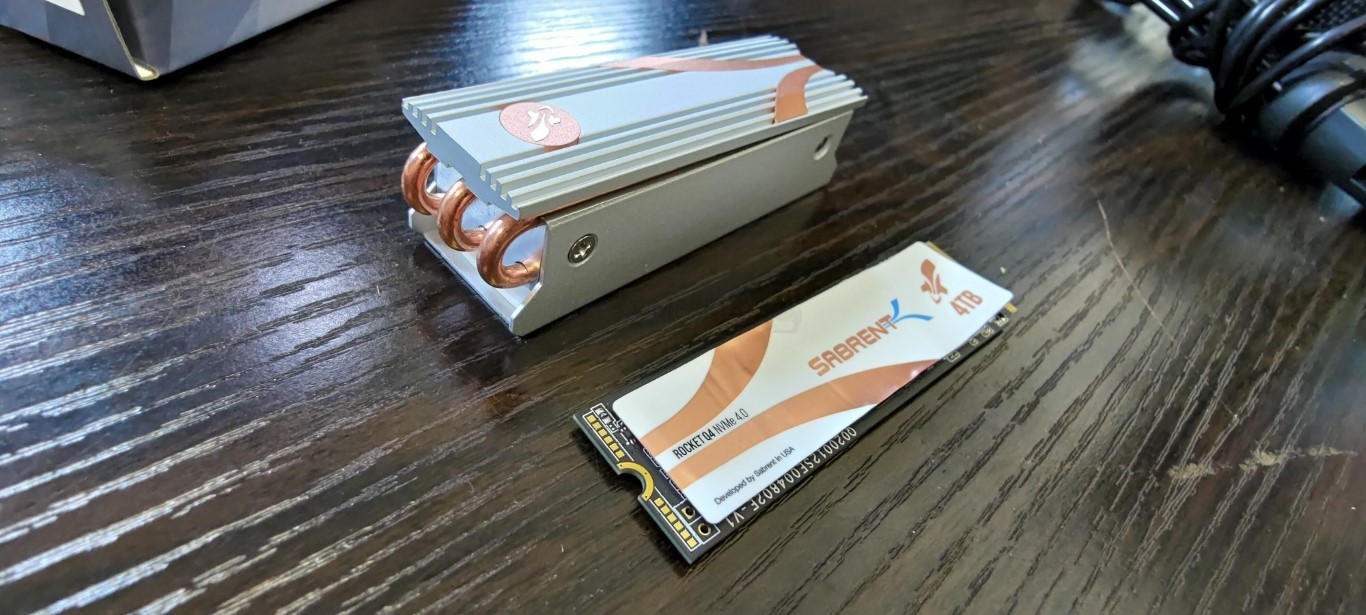
First, unlike a lot of SSDs that when purchased in complete packages with the first party/branded heatsink, the Sabrent Rocket Q4 does NOT arrive pre-installed in the heatsink. This is NOT a big deal, as its not exactly brain surgery to install an SSD inside a heatsink, however, two of the main benefits of buying an SSD+Heatsink combo is that 1) the thermal pads can/will be applied to the precisely most beneficial elements of the SSD (eg not a long, inefficient thermal pad, but selective area application to the SSD), and 2) a SSD+Heatsink combo might be applied at factory level with dust/air control meaning better sealed installation. These are very minor points, however it’s a real shame that the Sabrent Q4+Heatsink combo kit does not arrive readily attached at the point of manufacture.
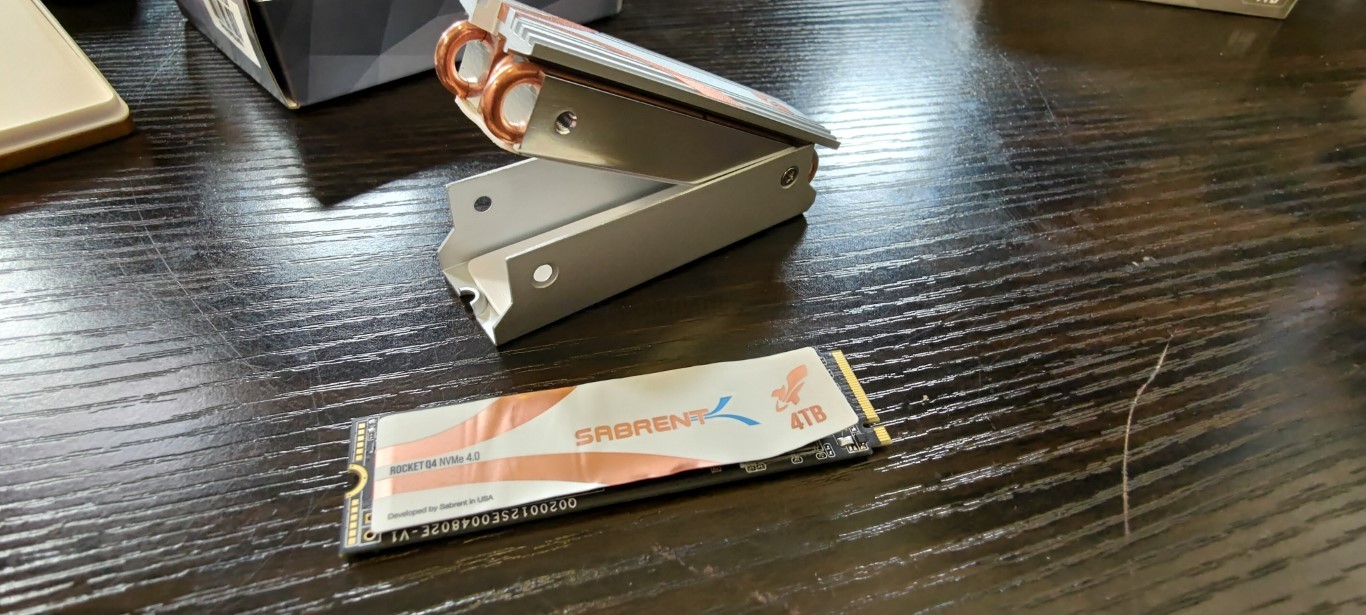
Another point that is worth noting, if largely not advisable, is if you are considering installing the Sabrent Rocket Q4 drive in your PS5. It is still technically below the recommended minimum for drive installation and you might encounter gameplay issues later, but nonetheless, the drive is supported and WAS displayed as usable by the PS5 system software (currently in the beta at the time of writing and not a full-public release feature).
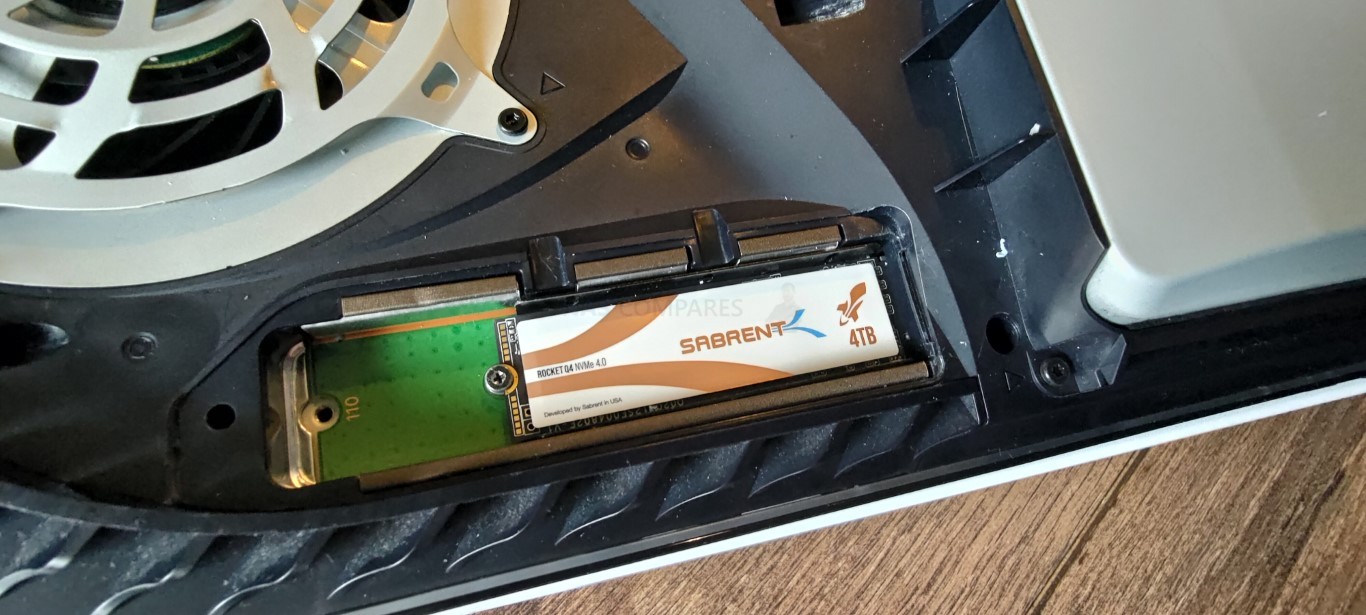
However, the 1st party Sabrent Heatsink is way, WAY too tall for PS5 expansion bay and will not allow you to install the m.2 cover by a big margin. You can still install the PS5 outer shell and panels, but this might well affect airflow too (TBC)
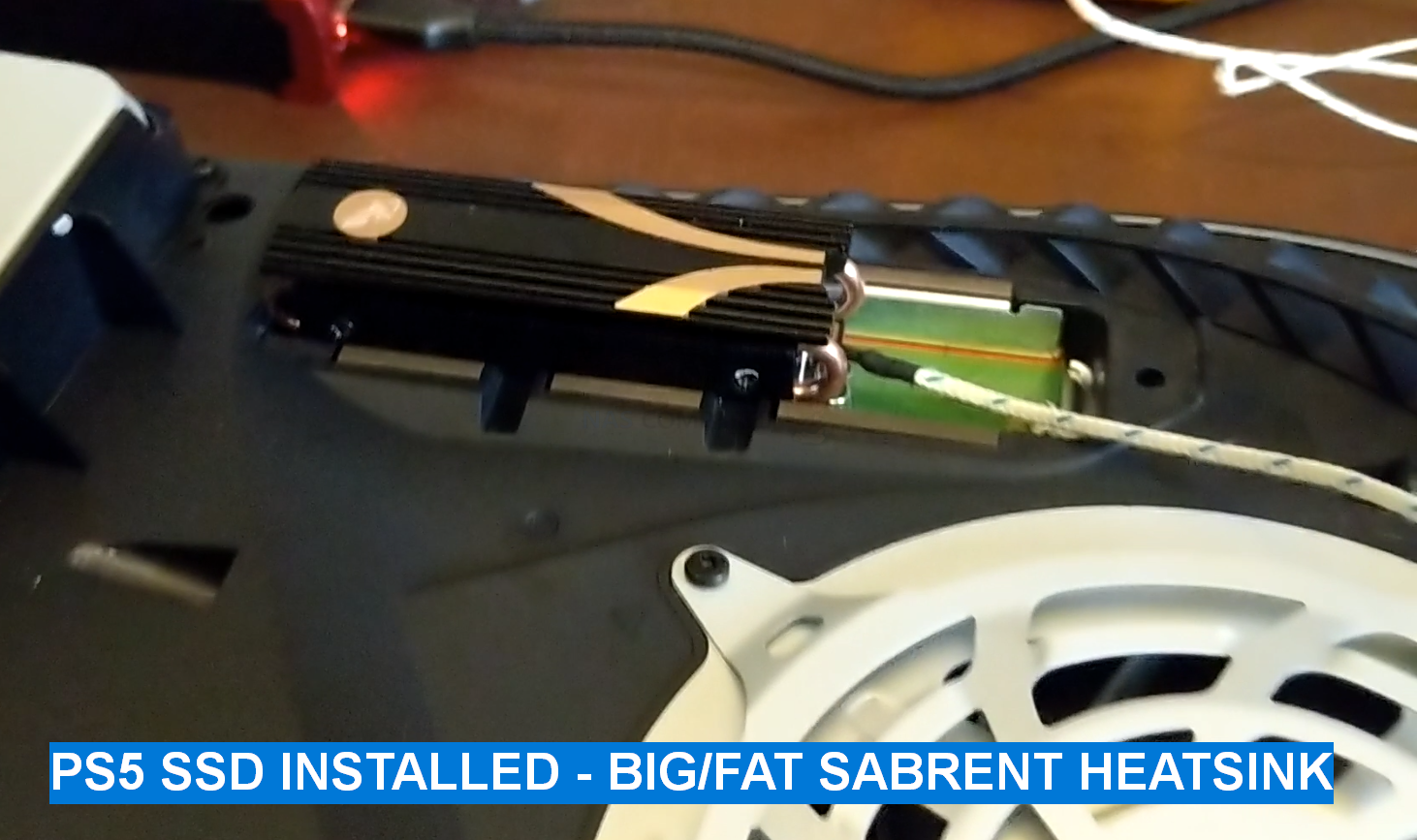
When you uninstall the Sabrent Rocket Q4 inside a PS5 with supported SSD expansion update in the expansion slot, the Playstation 5 System software recorded a highly unusual read speed of 5,621MB/s. This is significantly higher than the reported maximum 4,900MB/s Sequential Read that Sabrent themselves say the Rocket Q4 is capable of. So, take that measurement with a MASSIVE grain of salt!
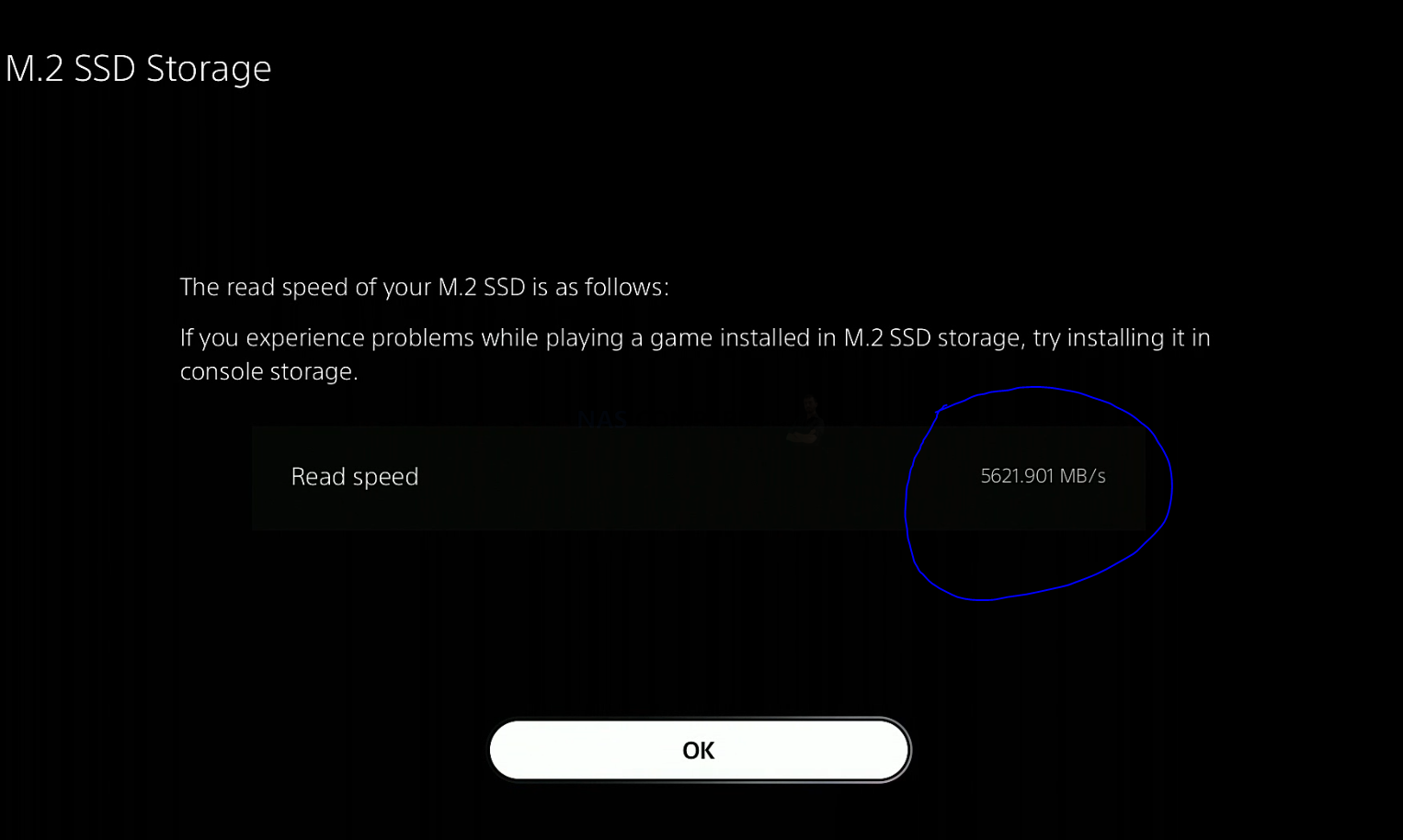
So that is the physical design of the Sabrent Rocket Q4 SSD. But what about the hardware components themselves? Does the Sabrent Rocket Q4 cut the mustard in terms of current generation hardware and protocols? Let’s find out.
Sabrent Rocket Q4 SSD Review – Hardware Specifications
As you might expect from an M.2 NVMe SSD that boldly promises performance of over 4,900MB/s sequential read (ie BIG data), the hardware specifications and architecture of the Sabrent Rocket Q4 are quite modern. Indeed, for all the big talk of the Seagate Firecuda 530 hardware (still currently the ‘score to beat’ PCIe Gen4 m.2 NVMe right now) being top tier, the Sabrent Rocket Q4 is pretty darn similar on the spec sheet! Of course, the context is important and knowing that this is a QLC NAND SSD is always going to be an early hurdle for this drive. Below is how it looks:
| SABRENT Rocket 4 + | SB-RKT4P-1TB
|
SB-RKT4P-2TB
|
SB-RKT4P-4TB
|
| Price in $ and $ | 1TB – $139 | 2TB – $299.99 | 4TB – $699.99 |
| PCIe Generation | PCIe Gen 4 | PCIe Gen 4 | PCIe Gen 4 |
| NVMe Rev | NVMe 1.3 | NVMe 1.3 | NVMe 1.3 |
| NAND | QLC NAND 96L | QLC NAND 96L | QLC NAND 96L |
| Capacity | 1TB Single Sided | 2TB Double Sided | 4TB Double Sided |
| Controller | Phison E16-PS5016 | Phison E16-PS5016 | Phison E16-PS5016 |
I know a lot of the above will seem needlessly technical, so below we can bring the most important considerations into sharper focus.
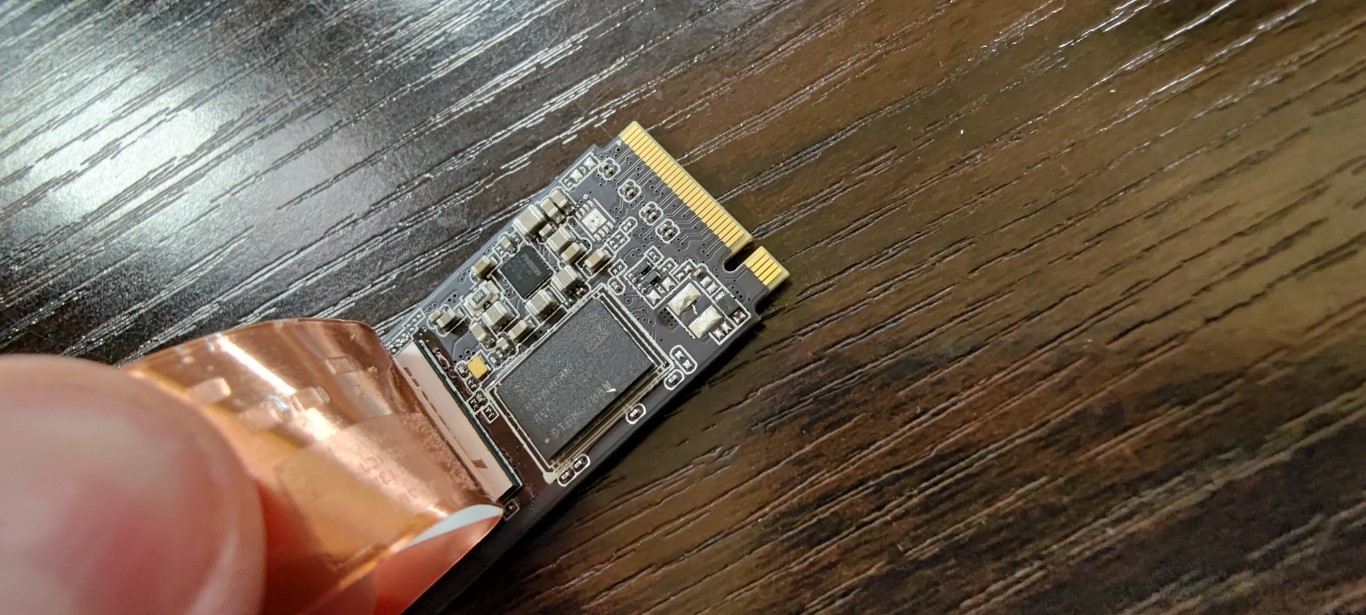
Hardware Focus of the Sabrent Rocket Q4 SSD Series
The first thing to focus on is the controller, that Phison E16. An SSD is much like a microcosm version of a whole computer. The Controller is equivalent to the CPU, and Phison are one of the bigger 3rd party SSD controller manufacturers in the world! I say 3rd party, because some long-running storage brands like Samsung and WD have most of their development and hardware engineering ‘in-house’ and use their own branded controllers. Whereas some brands source some/all components for their SSDs from 3rd parties – which is not necessarily a bad thing for both them and the industry (there are pros and cons on either side). Phison has been at the cutting edge of this subject for years now and the E16 was first introduced into the hardware market back in summer 2019 and is featured prominently on a number of PCIe4 SSDs that are now a pinch more affordable than the latest revision, the E18. This has created a two-tier system in the M.2 PCIe 4 market that some brands have used to produce two kinds of PCIe4 in their portfolio. A more affordable E16 SSD and a premium E18 SSD. Regardless of how the Phison E16 has slipped into the lower pricing/performance tier, this controller is still one of the biggest reasons that the Sabrent Rocket Q4 can actually back up its promises about the 4,700-4,900MB/s+ Sequential Read (sequential data = big chunks of data), despite the use of QLC NAND. However, that is not the only reason.
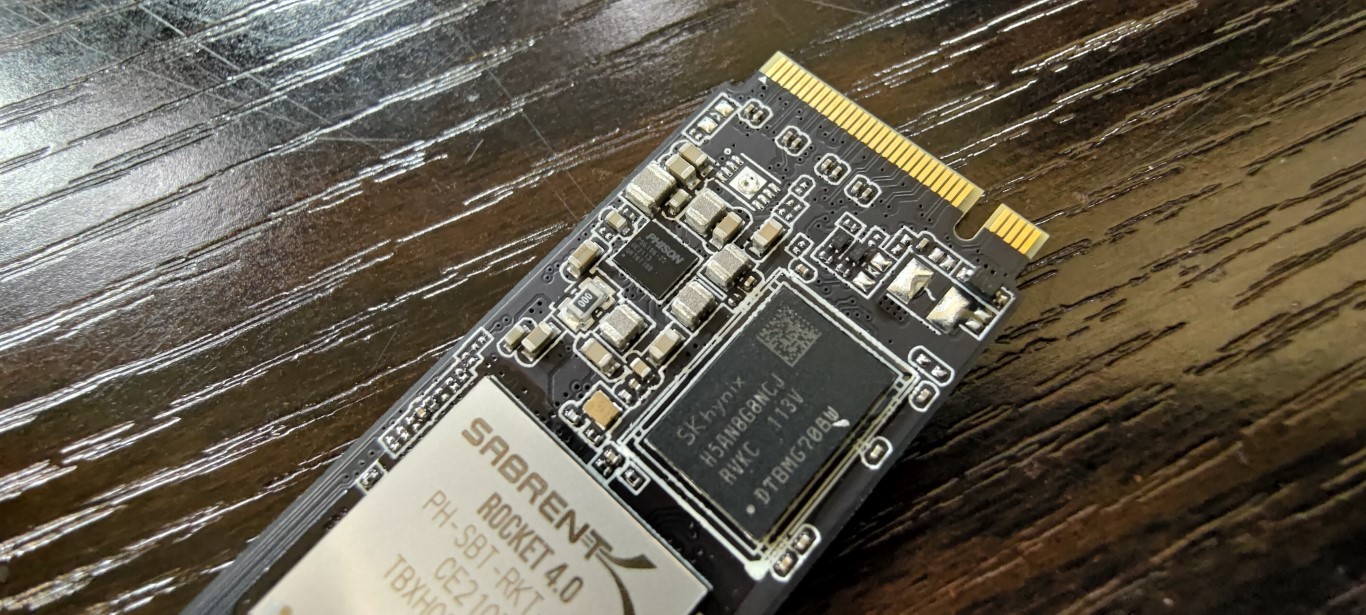
The NAND on the Sabrent Rocket Q4 is where the data lives! SSDs (as you no doubt know) do not use moving parts as found in traditional hard drives and instead uses cells that are charged and data is read/written to them in this process. The quality of the NAND and the layers used will make a big difference to the durability and performance of an SSD and although the Sabrent Rocket Q4 does not provide the best PCIe4 SSD in the industry at this tier right now (that, once again, goes to the Seagate Firecuda 530 at 176 layer 3D TLC NAND), it is bigger than most, arriving at 96 Layers of QLC NAND. This type of NAND is very much a double-edged sword and is debated in the SSD market when used. QLC (Quad Layer Cell) NAND allows much more storage capacity on the individual cells on the M.2 PCB, allowing the price point of each tier to be a great deal lower per TB than most other SSDs. However, this comes at a cost of performance and durability. The QLC NAND cannot stand up to the rigours of write activity in its lifespan as the 3D TLC NAND drives do and lead to a lower TBW and DWPD overall (around 0.1DWPD). Likewise the Read and Write performance on each capacity QLC NAND drive is noticeably lower than its competitors with the same controller,
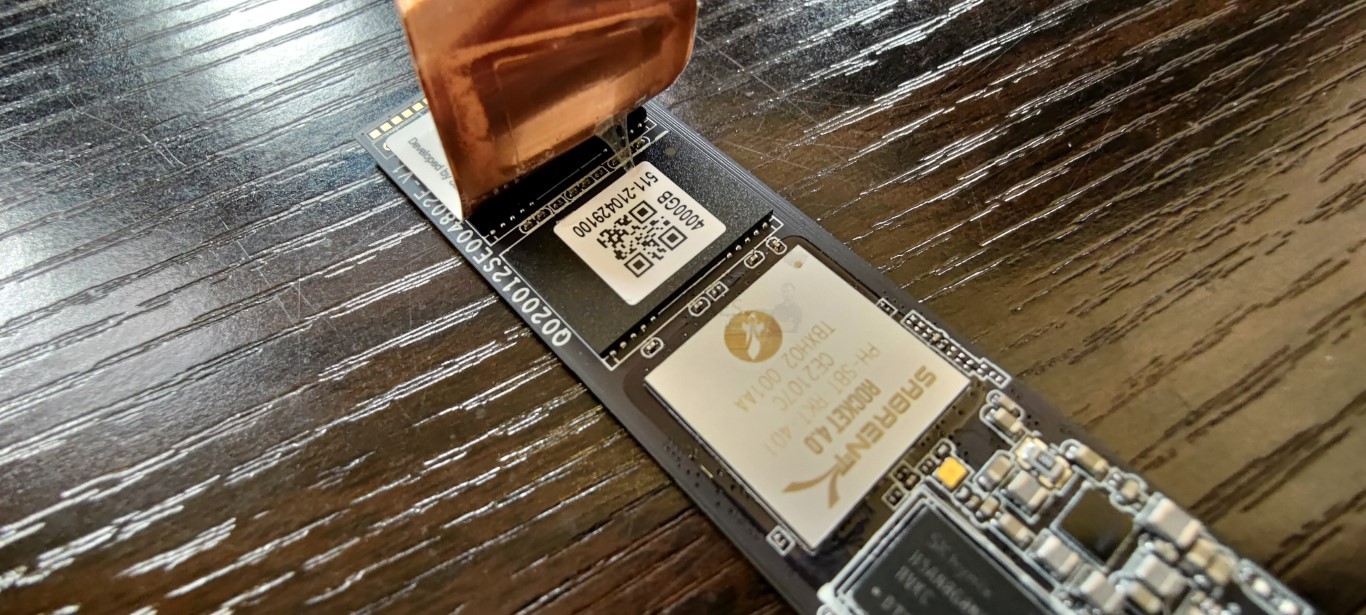
Much like the Controller on the Sabrent Rocket Q4 being the ‘CPU’, it also has an area of memory. The Sabrent Rocket Q4 SSD uses 1GB DDR4 memory on board and this in conjunction with the SSD provides a massive body of data handling resources for getting your data moving through the SSD and out of the m.2 NVMe PCIe 4 interface. The amount of memory scales in conjunction with the 1TB or 2TB SSD you use, with 2GB of DDR4 at the on the 2TB tier, 1GB DDR4 on the 1TB, etc.
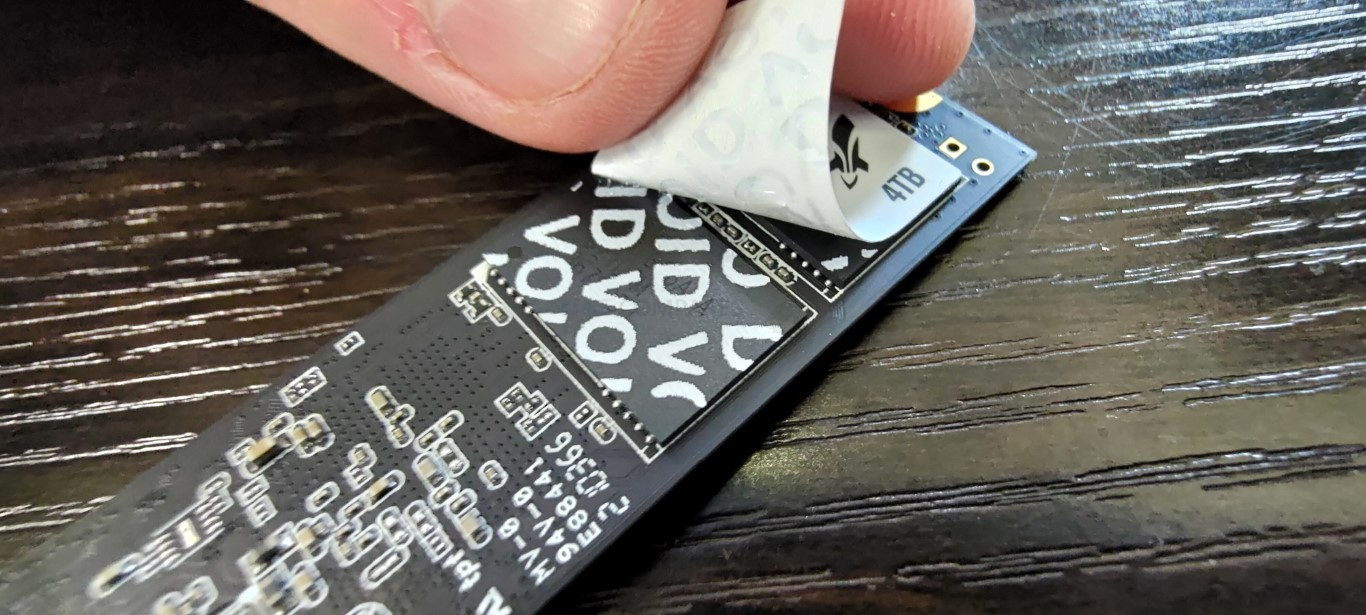
As mentioned, all available capacities of the Sabrent Rocket Q4 arrive at 2280 in length. This is quite normal for the 1TB and 2TB versions, but the fact that the 2TB can arrive on single-sided SSD boards is very impressive. Physical storage NAND is distributed evenly in order to space out the storage and allow even cooling, NAND wear and performance.
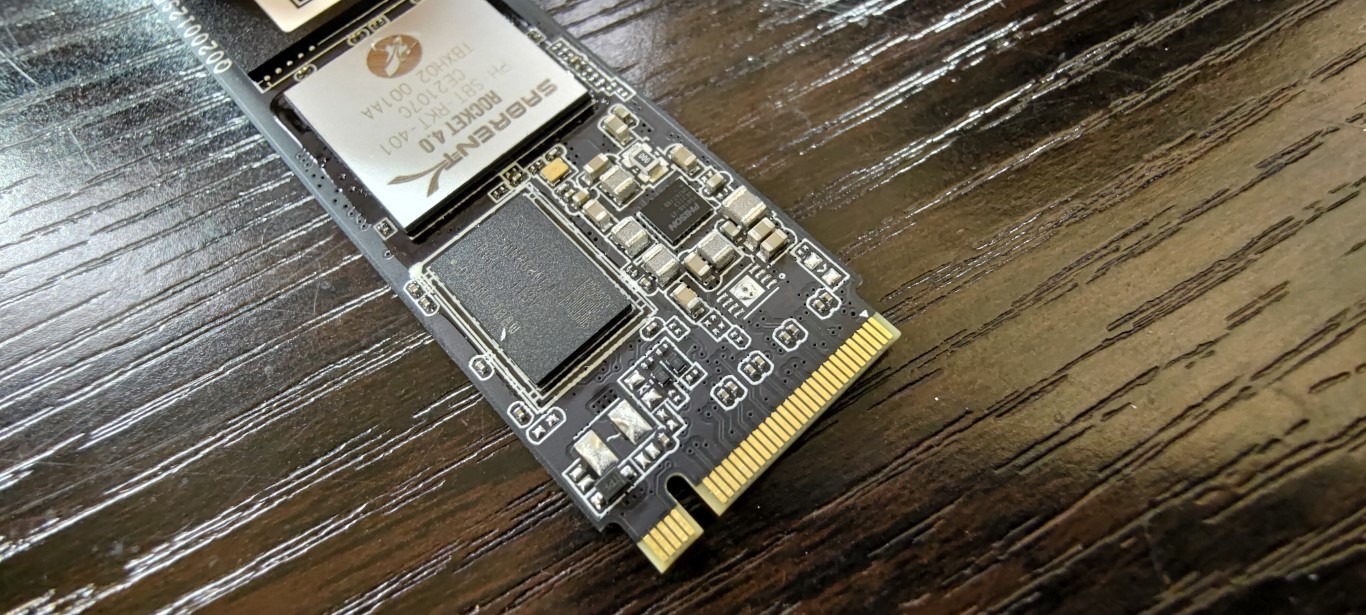
Finally, there is the M.2 NVMe connection. Not all m.2 SSDs are created equal and although M.2 SATA and M.2 NVMe look similar, they provide massively different performance and connectivity. However, the Sabrent Rocket Q4 takes it one step further, by using a newer generation of PCIe Connectivity. In short, M.2 NVMe SSDs are connected to the host PC/Console system via PCIe protocol (think of those slots that you almost always use for your graphics cards, but a much, MUCH smaller connector). These allow much larger bandwidth (ie maximum speed) for the connected storage media, Much like regular PCIe slots, they have different versions (i.E PCIe Gen 1, 2, 3, 4, etc) and also a multiplying factor (x1, x2, x4, etc). Up until around 18 months ago, the best M.2 NVMes were M.2 PCIe Gen 3×4 (so a maximum 4,000MB/s possible). However, never generation SSD like the Sabrent Rocket Q4 use PCIe Gen 4×4 (a potential 8,000MB/s possible) and it is only now that SSD controllers and NAND production has reached a point where it can catch up and fully saturate (i.e fill) this connection.
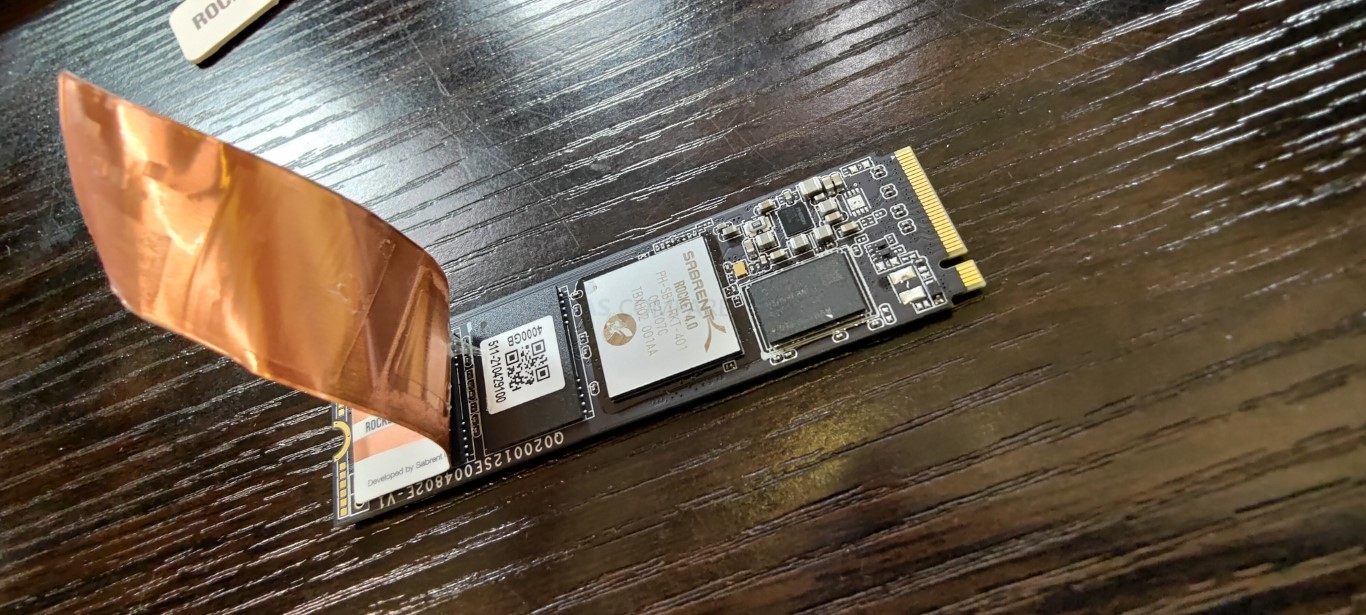
Overall, you really cannot fault the hardware inside/onboard the Sabrent Rocket Q4, as it is still (2-3 months after release) higher performing in sequential Read and Write than many other M.2 NVMe PCIe 4 SSDs released in that time. Before we go into the full testing, however, it is worth taking a moment to look closely at the reported performance benchmarks of the Sabrent Rocket Q4, as although the performance seems good, there are areas such as IOPS and endurance when compared with its main rivals that are worth taking into consideration.
Sabrent Rocket Q4 SSD Review – Official Stats First
Before we conduct our own testing on this SSD, Let’s take a closer look at the reported specifications and benchmarks first. The Sabrent Rocket Q4 SSD arrives in multiple capacities (below). The Prices currently are a little inconsistent (with each higher capacity tier actually having a higher price per GB – quite unusual) likely due to the hardware shortages, the Pandemic, Chia has affected SSD availability in the last 12 months and most recently the announcement that PS5 supports this SSD and it has increased the current price of both models around 15%! Below is a breakdown of how each Sabrent Rocket Q4 SSD compares:
| Brand/Series | Sabrent Rocket Q4
|
Seagate Firecuda 530
500GB – $149.99, 1TB – $239.99, 2TB – $489.99, 4TB – $949.99 |
WD Black SN850
|
| PCIe Generation | PCIe Gen 4 | PCIe Gen 4 | PCIe Gen 4 |
| NVMe Rev | NVMe 1.3 | NVMe 1.4 | NVMe 1.4 |
| NAND | QLC Micron 96L | 3D TLC Micron B47R 176L | BiCS4 96L TLC |
| Max Capacity | 4TB – Single Sided | 4TB – Double Sided | 2TB |
| Controller | Phison E16-PS5016 | Phison E18-PS5018 | WD_BLACK G2 |
| Warranty | 1yr/5yr | 5yr | 5yr |
| 500GB Model | N/A | ZP500GM3A013 | WDS500G1X0E-00AFY0 |
| Total Terabytes Written (TBW) | N/A | 640TB | 300TB |
| Mean Time Between Failures (MTBF, hours) | N/A | 1,800,000 | 1,750,000 |
| DWPD | N/A | 0.7DWPD | 0.3DWPD |
| 1TB Model | SB-RKTQ4-1TB | ZP1000GM3A013 | WDS100T1X0E-00AFY0 |
| Total Terabytes Written (TBW) | 200TB | 1275TB | 600TB |
| Mean Time Between Failures (MTBF, hours) | 1,800,000 | 1,800,000 | 1,750,000 |
| DWPD | 0.1DWPD | 0.7DWPD | 0.3DWPD |
| 2TB Model | SB-RKTQ4-2TB | ZP2000GM3A013 | WDS200T1X0E-00AFY0 |
| Total Terabytes Written (TBW) | 400TB | 2550TB | 1200TB |
| Mean Time Between Failures (MTBF, hours) | 1,800,000 | 1,800,000 | 1,750,000 |
| DWPD | 0.1DWPD | 0.7DWPD | 0.3DWPD |
| 4TB Model | SB-RKTQ4-4TB | ZP4000GM3A013 | N/A |
| Total Terabytes Written (TBW) | 800TB | 5100TB | N/A |
| Mean Time Between Failures (MTBF, hours) | 1,800,000 | 1,800,000 | N/A |
| DWPD | 0.1DWPD | 0.7DWPD | N/A |
However, despite the use of the Phison E16 controller and 96 layer NAND, the reported IOPS on each capacity is actually a noticeable degree lower than those reported by their competitors. Indeed, the Sabrent Rocket Q4 is one of the few E16 SSDs that utilizes QLC NAND and this inevitably takes its toll, producing noticeably lower performance and endurance compared with these two other drives. This is still very impressive for a QLC SSD, but it does clearly show the disparity. Of course, Sabrent has their premium/prosumer Sabrent Rocket 4 Plus series (the one we reviewed and compared HERE against the Seagate Firecuda 530) and that is much more comparable to these SSDs. But nevertheless, some users who have slightly more modest PC systems that might not fully be able to reach the 7,000MB/s highlighted by these high-end drives, will welcome the more affordable Sabrent Rocket Q4 drive as a more affordable drive that their system can work within the boundaries of. Just make sure you understand why this drive is more affordable in the market.
| Brand/Series | Sabrent Rocket Q4
|
Seagate Firecuda 530
500GB – $149.99, 1TB – $239.99, 2TB – $489.99, 4TB – $949.99 |
WD Black SN850
|
| 500GB Model | N/A | ZP500GM3A013 | WDS500G1X0E-00AFY0 |
| Sequential Read (Max, MB/s), 128 KB | N/A | 7000MB | 7000MB |
| Sequential Write (Max, MB/s), 128 KB | N/A | 3000MB | 4100MB |
| 1TB Model | SB-RKTQ4-1TB | ZP1000GM3A013 | WDS100T1X0E-00AFY0 |
| Sequential Read (Max, MB/s), 128 KB | 4700MB | 7300MB | 7000MB |
| Sequential Write (Max, MB/s), 128 KB | 1850MB | 6000MB | 5300MB |
| 2TB Model | SB-RKTQ4-2TB | ZP2000GM3A013 | WDS200T1X0E-00AFY0 |
| Sequential Read (Max, MB/s), 128 KB | 4800MB | 7300MB | 7000MB |
| Sequential Write (Max, MB/s), 128 KB | 3600MB | 6900MB | 5100MB |
| 4TB Model | SB-RKTQ4-4TB | ZP4000GM3A013 | |
| Sequential Read (Max, MB/s), 128 KB | 4900MB | 7300MB | N/A |
| Sequential Write (Max, MB/s), 128 KB | 3500MB | 6900MB | N/A |
| Brand/Series | Sabrent Rocket Q4 | Seagate Firecuda 530 | WD Black SN850 |
| 500GB Model | N/A | ZP500GM3A013 | WDS500G1X0E-00AFY0 |
| Random Read (Max, IOPS), 4 KB QD32 | N/A | 400,000 | 1,000,000 |
| Random Write (Max, IOPS), 4 KB QD32 | N/A | 700,000 | 680,000 |
| 1TB Model | SB-RKTQ4-1TB | ZP1000GM3A013 | WDS100T1X0E-00AFY0 |
| Random Read (Max, IOPS), 4 KB QD32 | 180,000 | 800000 | 1,000,000 |
| Random Write (Max, IOPS), 4 KB QD32 | 450,000 | 1000000 | 720,000 |
| 2TB Model | SB-RKTQ4-2TB | ZP2000GM3A013 | WDS200T1X0E-00AFY0 |
| Random Read (Max, IOPS), 4 KB QD32 | 350000 | 1,000,000 | 1,000,000 |
| Random Write (Max, IOPS), 4 KB QD32 | 700000 | 1,000,000 | 710,000 |
| 4TB Model | SB-RKTQ4-4TB | ZP4000GM3A013 | |
| Random Read (Max, IOPS), 4 KB QD32 | 350,000 | 1,000,000 | N/A |
| Random Write (Max, IOPS), 4 KB QD32 | 700,000 | 1,000,000 | N/A |
Yes, that is a LONG table, but you can immediately see that the Seagate Firecuda 530 raises the stakes on all of the key specifications. Although there are a number of micro reasons for this, the 176L TLC NAND is the biggest factor here. Yes, that is why the Firecuda 530 commands the higher price tag. Additionally, the WD Black arriving at a better price point than the Seagate FC 530 (though still, both are much more expensive per TB than the Sabrent Q4). However, for many, the additional cost for higher durability they may never need, peak performance their core system will not reach and IOPS rating that their larger file handling will never utilize will mean that holding out for the Firecuda or WD Black SN850 is not in their interest. Both SSDs (on paper at this stage!) are fantastic examples of where consumer and prosumer SSDs are evolving towards. But this doesn’t;t completely discount the Sabrent Rocket Q4 from buyer’s options, being a more affordable alternative. Let’s get the Sabrent Rocket Q4 on the test machine!
Testing the Sabrent Rocket Q4 m.2 PCIE4 NVMe SSD
The Sabrent Rocket Q4 was selected for this test and it was tested using multiple benchmark tools, from a cold boot, in the 2nd storage slot (i.e not the OS drive). Each test was conducted three times (full details of this are shown in the YouTube Review of the Sabrent Rocket Q4 over on NASCompares):
Test Machine:
- Windows 10 Pro Desktop System
- Intel i5 11400 Rocket Lake – 6-Core 2.6/4.4Ghz
- 16GB DDR4 2666MHz Memory
- Intel B560M mATX Motherboard
- OS Storage, Seagate Firecuda 120 SSD
- Test SSD connected to Secondary PCIe Gen 4 M.2 Slot
Using CrystalDisk, we got a good measure of the drive and verified that this PCIe Gen 4 x4 SSD was indeed using the 4×4 lane. Additionally, the temp averaged out around 44C between each test being conducted.
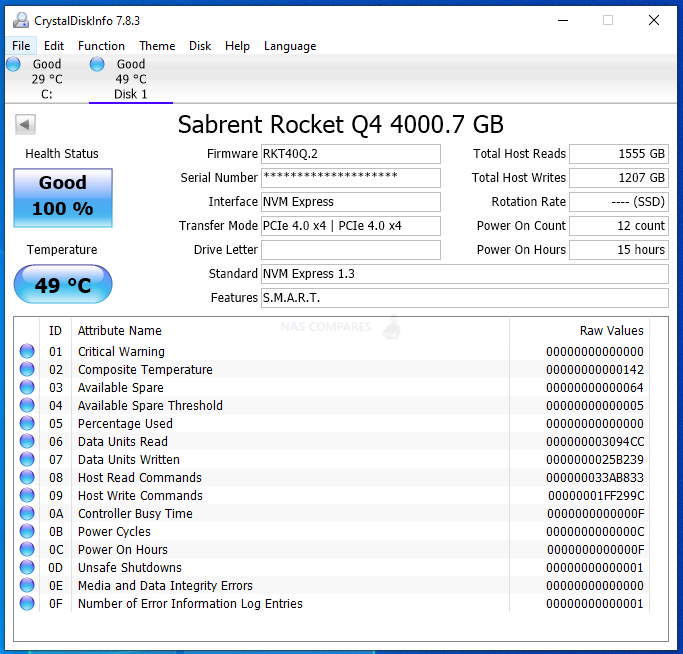
The first tests were conducted using the ATTO disk benchmark software. The first was a 256MB test file size and below is a breakdown of the transfer rates and IOPS. The 2nd Test was a 1GB test file and finally, the last test was with a 4GB test file. The system was given 1-minute cool downtime between tests, no screen recording software was used (remove overhead) and a heatsink was used throughout (no reboots)
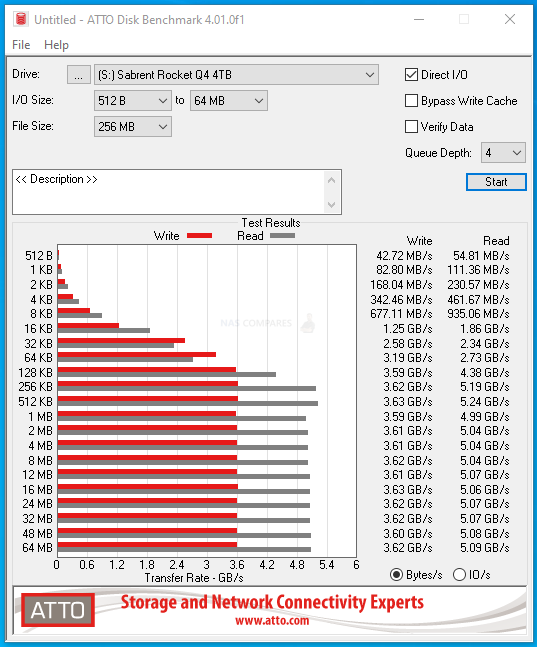 |
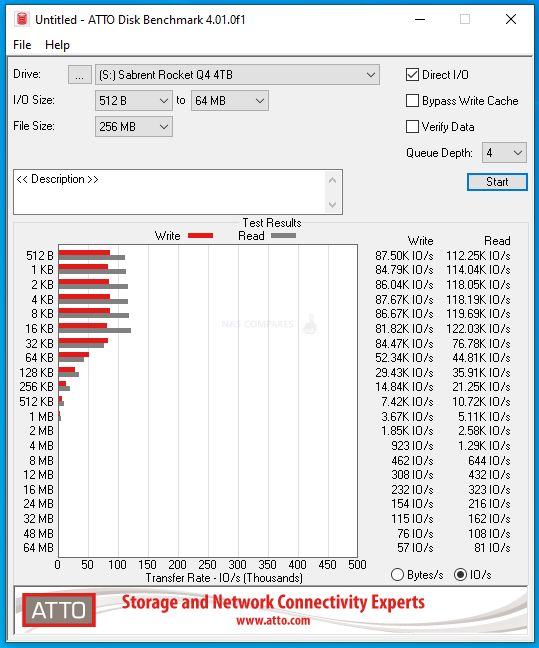 |
ATTO Disk Benchmark Test #1
256MB File PEAK Read Throughput = 5.24GB/s
256MB File PEAK Write Throughput = 3.62GB/s
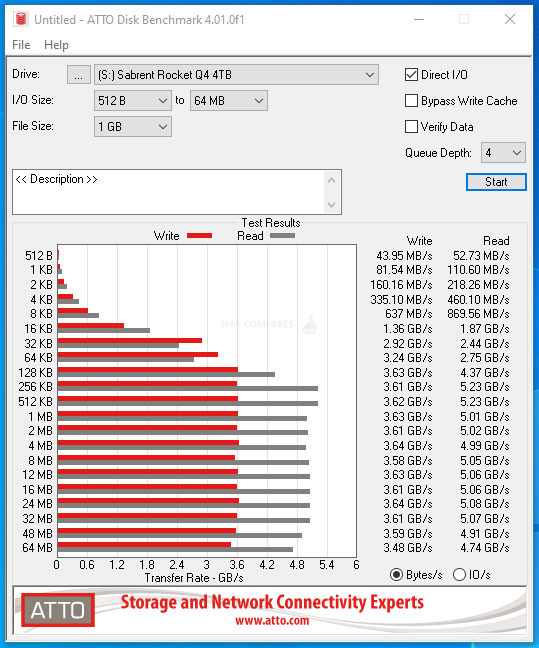 |
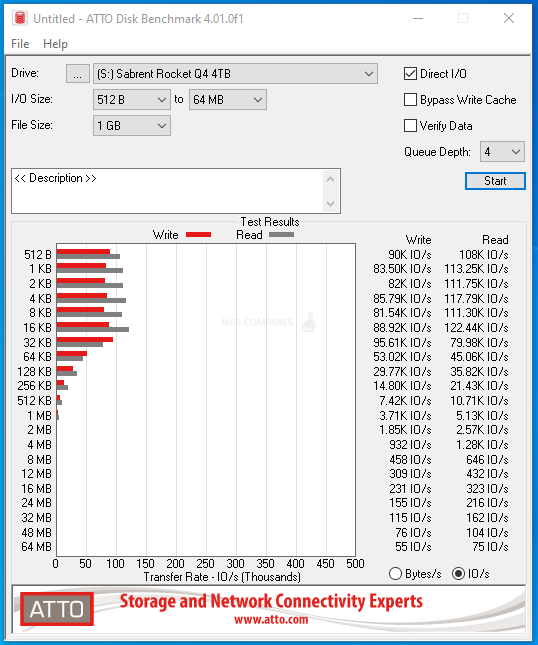 |
ATTO Disk Benchmark Test #2
1GB File PEAK Read Throughput = 5.23GB/s
1GB File PEAK Write Throughput = 3.64GB/s
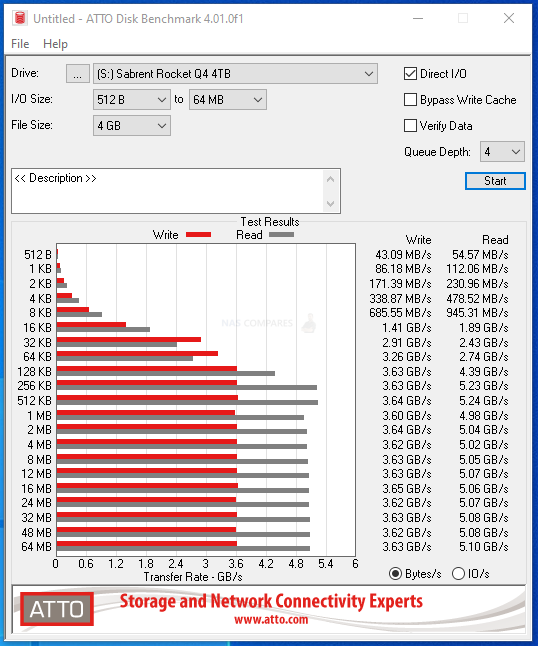 |
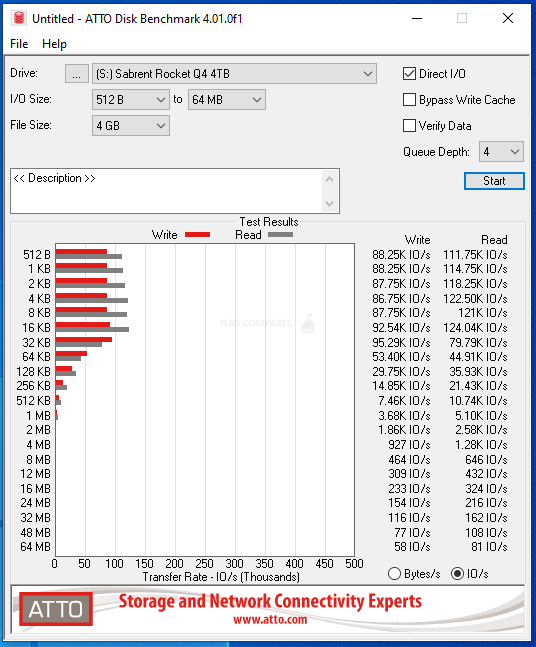 |
ATTO Disk Benchmark Test #3
4GB File PEAK Read Throughput = 5.24GB/s
4GB File PEAK Write Throughput = 3.64GB/s
Next, although the ATTO tests were quite good, but not what I would have hoped from this SSD, so I moved on to the Crystal Disk Mark testing to see how well it would handle our lasts barrage of tests. The first test was the 1GB file testing, which measured both sequential and random, as well as the read and write IOPS. Test were conducted on a 1GB, 4GB and 16GB Test File. I also included a mixed 70/30 read and write task to give a little bit more of a realistic balanced workload. These tests were conducted with 1-minute cooling break in between
CRYSTALDISK MARK 1GB TEST
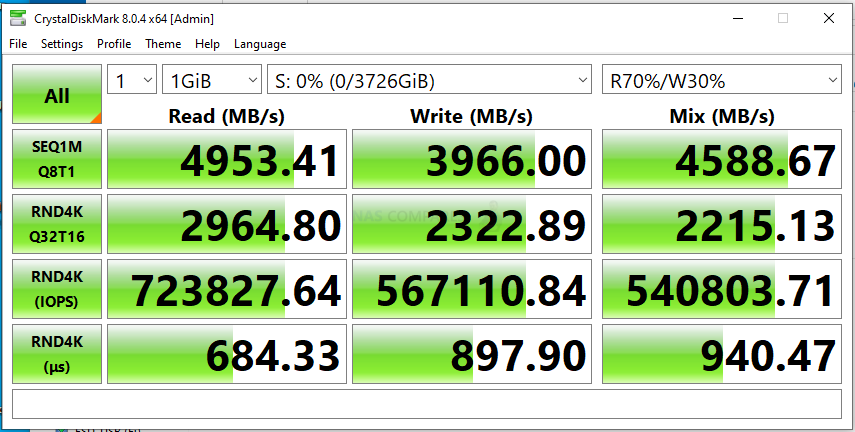
CRYSTALDISK MARK 4GB TEST
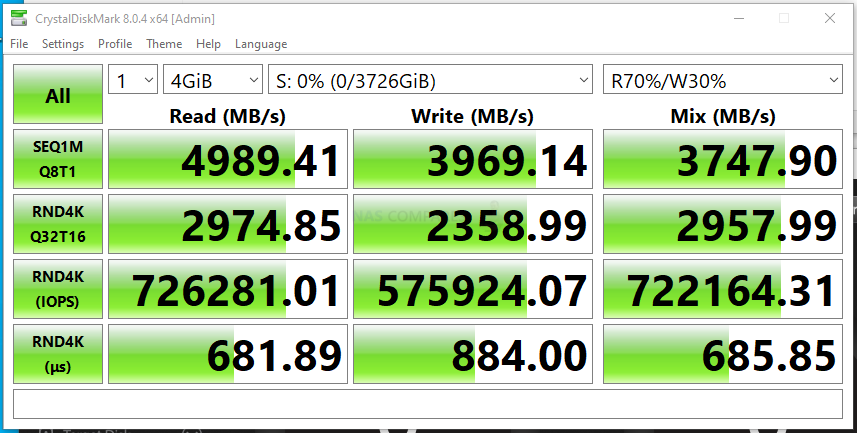
CRYSTALDISK MARK 16GB TEST
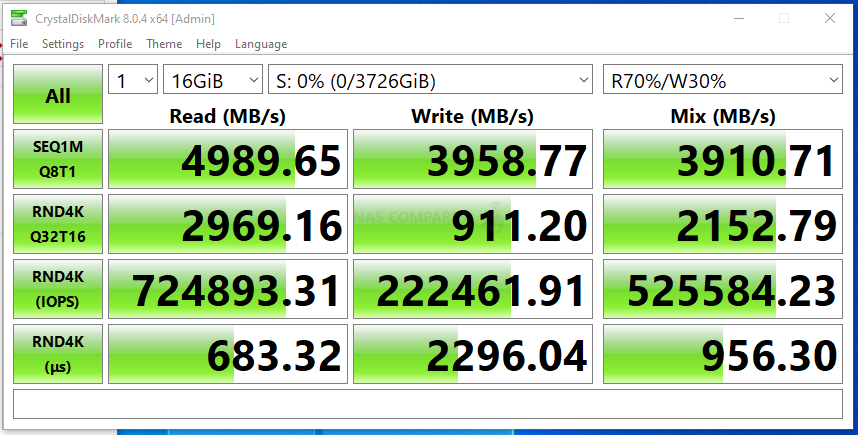
Next, I switched to AS SSD benchmark. A much more thorough test through, I used 1GB, 3GB and 5GB test files. Each test includes throughput benchmarks and IOPS that are respective to the larger file sizes (important, if you are reading this and trying to compare against the reported 4K IOPS from the manufacturer).
AS SSD Benchmark Test #1
 |
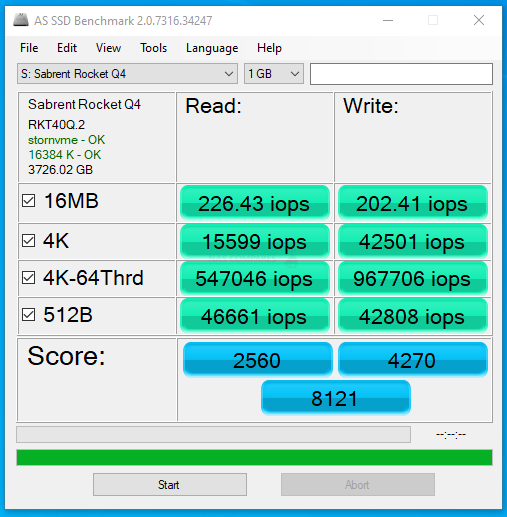 |
AS SSD Benchmark Test #2
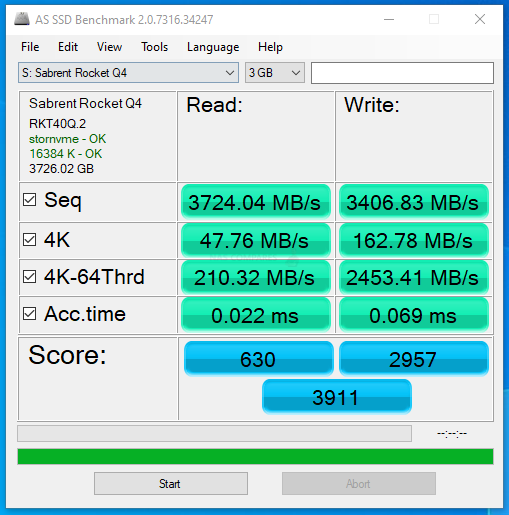 |
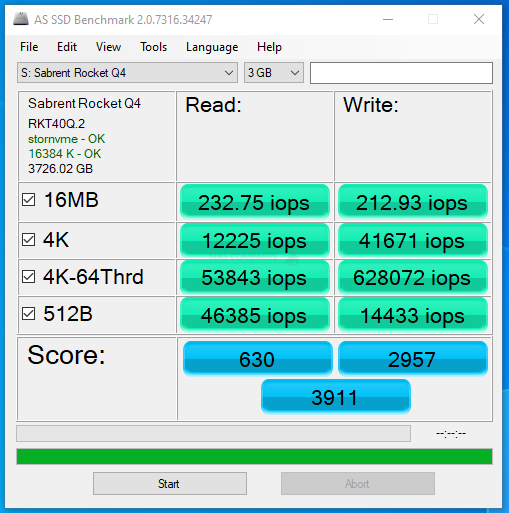 |
AS SSD Benchmark Test #3
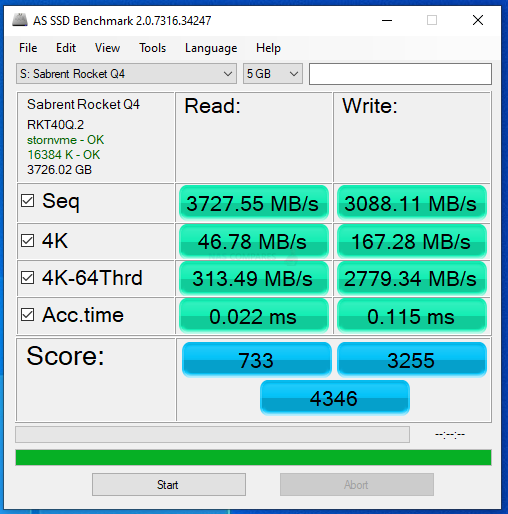 |
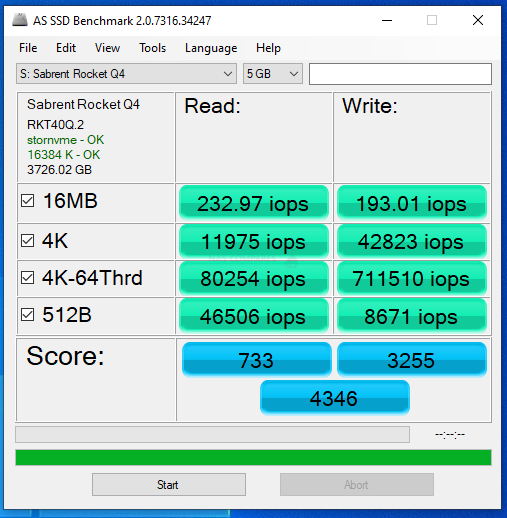 |
Ordinarily, I would introduce tests like BlackMagic and AJA into the mix here, but even a short burst of testing on an NVMe like this would over saturate the cache memory on board. Nevertheless, in the short term we still could ascertain the reported performance on 1GB, 4GB and 16GB file testing was:
1GB AJA File Test Results (Peak) = 4502MB/s Read & 3958MB/s Write

4GB AJA File Test Results (Peak) = 4361MB/s Read & 3869MB/s Write

16GB AJA File Test Results (Peak) = 4371MB/s Read & 3888MB/s Write

Overall, the Sabrent Rocket Q4 was certainly able to provide some solid performance, as well as potentially exceed the test figures here on a more powerful machine. Given the reported Read and Write statistics that the brand has stated publically, I think there is enough evidence here to back up those claims. IOPs were a little lower than I expected, but again, we were testing very large file types, so this would have to be taken in context.
Sabrent Rocket Q4 SSD Review – Conclusion
If you are considering the Sabrent Rocket Q4 SSD and are WELL AWARE of what QLC NAND is and exactly WHY this drive is noticeably lower in price than the likes of the Sabrent Rocket 4 Plus, Firecuda 520 and WD Black SN850 – then I can 100% say that the Sabrent Q4 is easily one of the best examples of Quad Layer NAND utilization in the market right now. It leverages the dips in performance and durability inherent in QLC NAND against the massively increased bandwidth of PCIe4 remarkably well. Additionally, it arrives on the scene as easily the lowest price PCIe4 NVMe SSD on the market right now, along with impressive build quality and presentation (Acronis drive cloning software included too). The warranty registration seems like a bit of a needlessly ambiguous hurdle and I am surprised that an 8TB Rocket Q4 does not exist right now, but aside from those factors, this is a great example of presenting a QLC SSD done very well. Just make sure you are fully clued up on the reasons why QLC NAND is a little shunned in prosumer SSD circles.

| PROs of the Sabrent Rocket Q4 | CONs of the Sabrent Rocket Q4 |
| The Most Affordable PCIe4 M.2 SSD on the Market
Still Using a Great Controller in the Phison E16 Good Quality Build 4TB Version available Good for those with Modest PCIe4 systems Includes Acronis True Image to clone/move OS to drive PCIe4 SSDs at PCIe3 Prices |
QLC NAND = lower performance and lower durability
No 8TB model is currently available (one of the benefits of QLC NAND at 2280 length) Inclusive Heatsink Model does not arrive pre-installed/attached |
🔒 Join Inner Circle
Get an alert every time something gets added to this specific article!
This description contains links to Amazon. These links will take you to some of the products mentioned in today's content. As an Amazon Associate, I earn from qualifying purchases. Visit the NASCompares Deal Finder to find the best place to buy this device in your region, based on Service, Support and Reputation - Just Search for your NAS Drive in the Box Below
Need Advice on Data Storage from an Expert?
Finally, for free advice about your setup, just leave a message in the comments below here at NASCompares.com and we will get back to you. Need Help?
Where possible (and where appropriate) please provide as much information about your requirements, as then I can arrange the best answer and solution to your needs. Do not worry about your e-mail address being required, it will NOT be used in a mailing list and will NOT be used in any way other than to respond to your enquiry.
Need Help?
Where possible (and where appropriate) please provide as much information about your requirements, as then I can arrange the best answer and solution to your needs. Do not worry about your e-mail address being required, it will NOT be used in a mailing list and will NOT be used in any way other than to respond to your enquiry.

|
 |


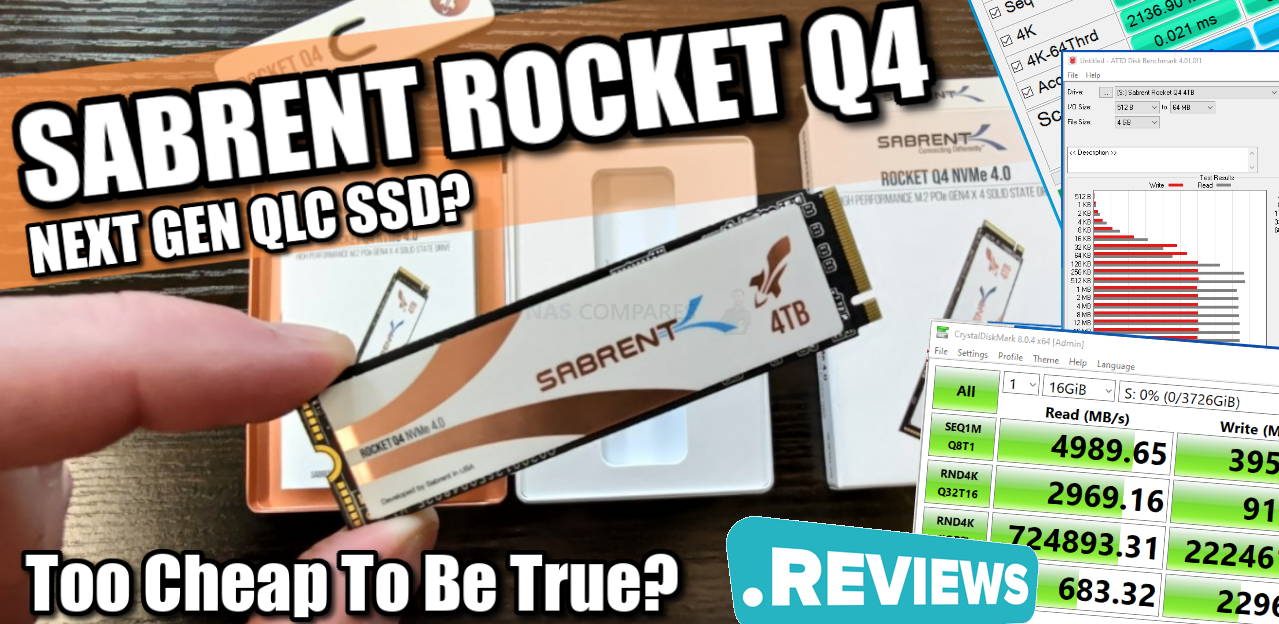

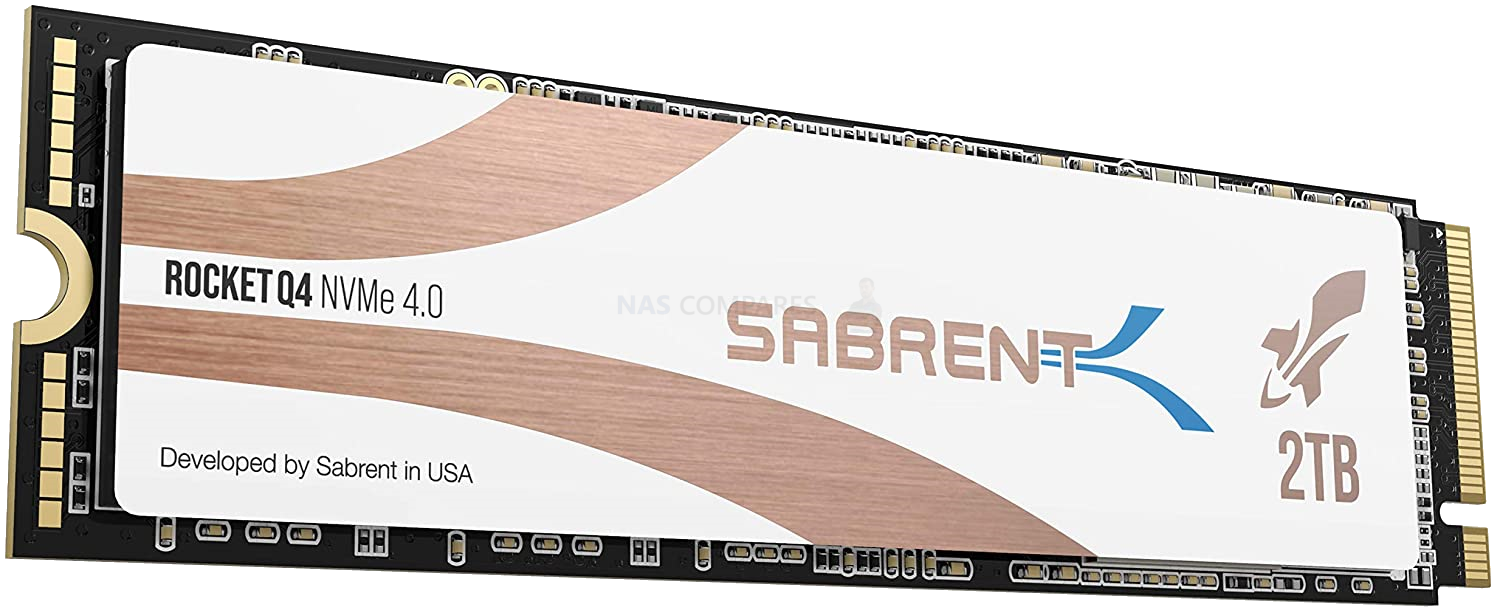



How does this compare Silicon Power 2TB NVMe 4.0 Gen4 PCIe M.2 SSD need ur opinion
REPLY ON YOUTUBE
Is this ssd good for playstation 5?
REPLY ON YOUTUBE
I love watching your videos. Thank you for grinding through all these ssd cards for everyone. I learn something new everything I watch something you’ve produced.
REPLY ON YOUTUBE
Thanks for all your videos
REPLY ON YOUTUBE